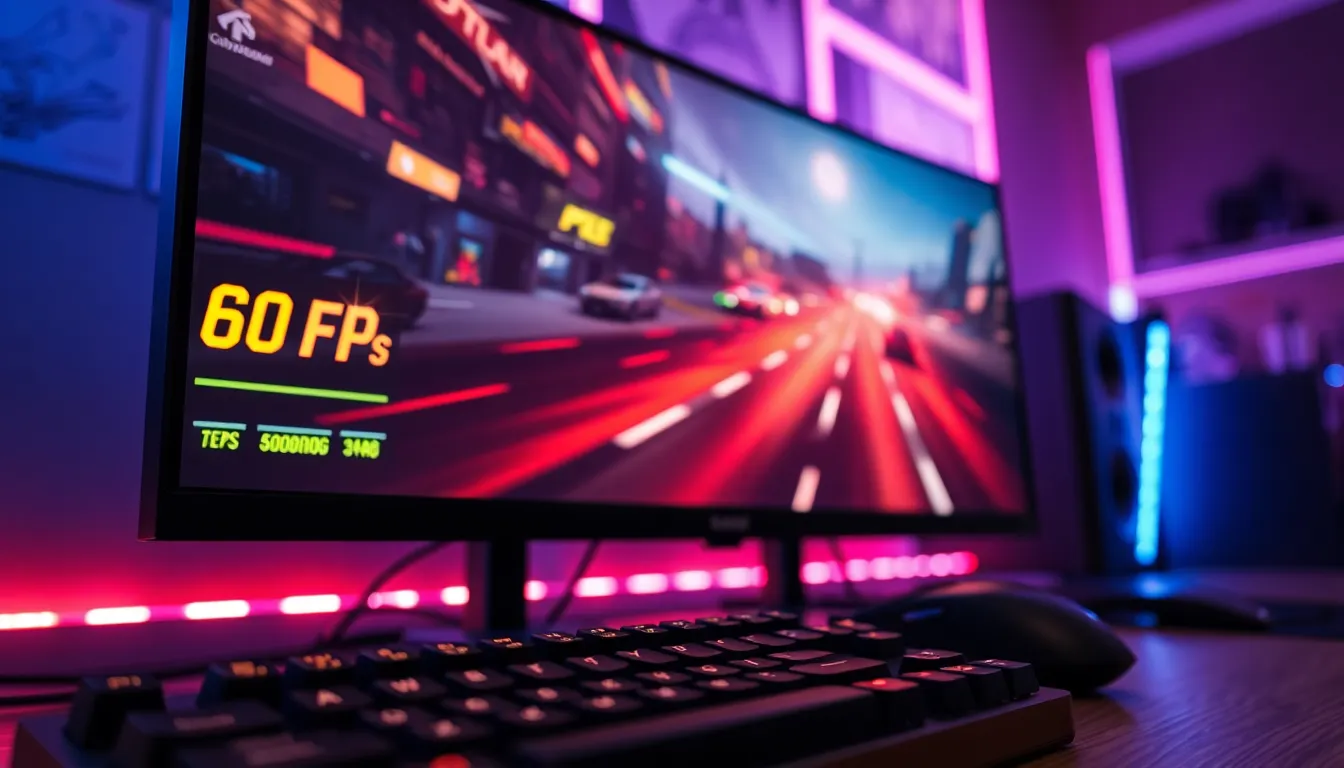In the gaming universe, FPS isn’t just a catchy abbreviation; it’s the holy grail for players seeking smooth and exhilarating experiences. Imagine trying to shoot a virtual enemy while your game stutters like a toddler on roller skates. Not fun, right? That’s where FPS, or frames per second, comes into play. It’s the magic number that determines how many frames your game displays each second, directly impacting how fluid and responsive your gameplay feels.
Table of Contents
ToggleUnderstanding FPS in Gaming
FPS, or frames per second, measures the number of individual frames displayed on-screen each second. This metric indicates how smoothly a game runs, impacting everything from responsiveness to visual clarity.
Definition of FPS
FPS quantifies the frequency at which consecutive images, or frames, appear in a video game. For instance, a game running at 60 FPS displays 60 frames every second. The higher the FPS, the smoother the visual experience. Lower FPS, such as 30, can lead to choppy gameplay that feels sluggish. Many gamers aim for 60 FPS or higher for optimal performance.
Importance of FPS
FPS significantly influences gameplay quality and responsiveness. A high frame rate enhances fluid motion and allows for quicker reactions during gameplay, which is crucial in competitive settings. Games featuring low FPS often exhibit problems like motion blur and stuttering, creating frustrating experiences. Furthermore, higher FPS can improve player immersion by rendering more details and smoother animations. Consistent FPS ensures enjoyable gaming, especially in fast-paced genres like first-person shooters and racing games.
Measuring FPS

FPS measurement is essential for evaluating game performance. Accurate measurement ensures players experience smooth gameplay.
Tools for Measuring FPS
Various tools exist to measure FPS effectively. Games often include built-in FPS counters that provide real-time data. Third-party software like Fraps and MSI Afterburner also offers precise FPS readings. These tools allow users to monitor performance while playing. Developers can analyze FPS trends in gameplay to optimize graphics settings. Ensuring optimal FPS levels leads to enhanced gaming experiences and satisfaction.
Understanding FPS Rates
FPS rates indicate how many frames the system renders each second. A rate of 30 FPS often results in acceptable gameplay, though some genres require higher rates. Games with 60 FPS offer smoother motion, improving player reaction times. Competitive gamers typically prefer rates above 144 FPS for the quickest response rates. Variability in FPS indicates performance stability, with consistent rates being more desirable. Recognizing the importance of FPS helps players select appropriate hardware for their gaming needs.
Impact of FPS on Gameplay
FPS significantly influences how players interact with games. Variations in frame rates directly affect the overall experience.
High FPS vs Low FPS
High FPS creates a seamless gaming experience. Smooth animations and fast-paced responsiveness characterize gameplay at 60 FPS or above. Players experience precise controls, enhancing their ability to make quick decisions. Low FPS often leads to noticeable lag, creating stuttering graphics and degraded experience. While 30 FPS may suffice for casual gaming, competitive environments demand at least 144 FPS. Players find it easier to enjoy immersive environments when frame rates are stable and high.
FPS and Game Performance
Game performance heavily relies on FPS, impacting visual clarity and responsiveness. Accurate FPS measurement allows developers to refine graphics settings and optimize gameplay. High FPS improves player immersion by ensuring fluid motion, while low FPS often results in motion blur and choppy visuals. Tools like Fraps and MSI Afterburner help monitor FPS, giving insights into performance trends. Players benefit from understanding how different FPS levels affect their favorite genres, ensuring they choose the right hardware for optimal performance. High-quality graphics paired with appropriate FPS can elevate the gaming experience and maintain engagement.
Factors Affecting FPS
Several elements influence FPS, impacting the gaming experience significantly. Understanding these factors helps players enhance their gameplay and optimize performance.
Hardware Influence
Hardware plays a crucial role in determining FPS. High-performance graphics cards significantly increase frame rates compared to lower-end models. CPUs also affect FPS; stronger processors handle complex calculations more efficiently. Additionally, RAM size matters; systems with more RAM better manage processes and reduce lag. Monitor refresh rates influence perceived FPS too; a 144 Hz monitor displays frames more smoothly than a 60 Hz screen. Upgrading these hardware components ultimately leads to improved FPS and a more enjoyable gaming experience.
Software Influence
Software optimizes and can constrict FPS performance. Game settings directly affect the rendering quality; lowering graphics settings often results in higher FPS. Effective drivers ensure hardware operates at peak efficiency, making regular updates essential. Background applications consume resources; closing unnecessary programs can free up valuable processing power. Game engines vary in performance; some are optimized for higher frame rates than others. Developers frequently release patches that improve FPS stability and address bugs, reinforcing the importance of maintaining up-to-date software to achieve optimal gaming performance.
FPS is a vital component of gaming that directly influences the player experience. Higher frame rates lead to smoother visuals and quicker responses which are essential in competitive gaming. Understanding FPS helps players choose the right hardware and settings to enhance their gameplay.
Monitoring FPS through various tools allows both players and developers to optimize performance and ensure a stable gaming environment. As technology evolves FPS will continue to play a significant role in shaping the future of gaming. Prioritizing a balance between graphics quality and frame rates can elevate the overall enjoyment of any game.





